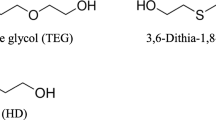Degradative characteristics were studied using specimens of three polyurethane-based elastomeric modules that were treated in solutions of varying acidity, oxygen content and temperature. After periods of 10 and 100 days, molecular weight distribution changes, mechanical property changes and elemental chemistry changes were studied using gel permeation chromatography (GPC), stress-relaxation testing and X-ray photoelectron spectroscopy (XPS), respectively. As determined through analyses of the molecular, mechanical, and elemental changes after treatment, the degradative mechanism was influenced by whether the polyurethane was polyester-based or polyether-based, and the degree of structural degradation was influenced by the type and duration of conditioning treatment. Degradation of the polyester-based materials after treatment was dominated by a chain scission mechanism; conversely, the degradation of the polyether-based material was dominated by a crosslinking mechanism. Among the conditioning treatments, the combined effects of an increase in acidity, oxygen content and temperature most influenced the degree of degradation with time, with the increase in temperature having the greatest effect of any of the single variables investigated.
Similar content being viewed by others
References
M. Szycher, J. Biomater. Applic. 3 (1988) 297.
P. Wright and A. P. C. Cumming, in “Solid polyurethane elastomers” (Gordon and Breach, New York, 1969) p. 38.
N. Grassie and G. Scott, in “Polymer degradation and stabilisation” (Cambridge University Press, New York, 1985) p. 213.
Q. Zhao, N. Topham, J. M. Anderson, A. Hiltner, G. Lodoen and C. R. Payet, J. Biomed. Mater. Res. 25, (1991) 177.
M. Jayabalan, N. Shunmuga Kumar, K. Rathinam and T. V. Kumari, J. Biomed. Mater. Res. 25 (1991) 1431.
F. M. Benoit, J. Biomed. Mater. Res. 27 (1993) 1341.
M. Bouvier, A. S. Chawla and I. Hinberg, J. Biomed. Mater. Res. 25 (1991) 773.
B. J. Tyler and B. D. Ratner, in “Degradation phenomena of polymeric biomaterials” (Springer-Verlag, New York, 1992) p. 9.
K. Isama, S. Kojima and A. Nakamura, J. Biomed. Mater. Res. 27 (1993) 539.
M. D. Lelah and S. L. Cooper, in “Polyurethanes in medicine” (CRC Press, Boca Raton, FL, 1986) p. 27.
K. B. Stokes, J. Biomater. Applic. 3 (1988) 228.
N. Hasirci, in “High performance biomaterials” (Technomic, Lancaster, PA, 1991) p. 71.
A. Takahara, A. J. Coury, R. W. Hergenrother and S. L. Cooper. J. Biomed. Mater. Res. 25 (1991) 341.
G. Oertel, in “Polyurethane handbook” (Hanser, New York, 1985) p. 385.
T. Alfrey, in “Mechanical behavior of high polymers” (Interscience, New York, 1948) p. 493.
D. K. Han, K. D. Park, K-D. Ahn, S. Y. Jeong and Y. H. Kim, J. Biomed. Mater. Res. 23 (1989) 87.
A. Takahara, N. J. Jo and T. Kajiyama, J. Biomater. Sci. Polymer Edn 1 (1989) 17.
Author information
Authors and Affiliations
Rights and permissions
About this article
Cite this article
Stevenson, J.S., Kusy, R.P. Structural degradation of polyurethane-based elastomeric modules. J Mater Sci: Mater Med 6, 377–384 (1995). https://doi.org/10.1007/BF00120277
Received:
Accepted:
Issue Date:
DOI: https://doi.org/10.1007/BF00120277




